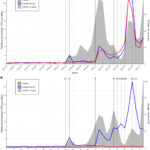Appendicitis is a painful condition that requires prompt medical attention. It occurs when your appendix, a small, finger-shaped pouch attached to your colon, becomes inflamed and filled with pus. Understanding where appendix pain is located and what other symptoms to look for is crucial for early diagnosis and treatment.
Pinpointing Appendix Pain Location
The classic sign of appendicitis is abdominal pain, but Where Is Appendix Pain exactly? Typically, appendicitis pain starts in the center of your abdomen, near your belly button (navel). This initial pain might feel crampy and comes and goes, making it seem like any other stomach upset. However, over a few hours, the pain shifts and intensifies, moving to the lower right side of your abdomen.
This shift happens because as the appendix becomes more inflamed, it irritates the lining of the abdomen in the lower right quadrant. This area becomes increasingly tender to the touch. The pain is usually described as sharp and constant, and it worsens when you move, cough, sneeze, or even take deep breaths.
It’s important to note that while the lower right abdomen is the most common location for appendix pain, the exact location of appendix pain can vary. In some individuals, especially children and pregnant women, the pain might be felt in different areas of the abdomen due to variations in appendix position. During pregnancy, for example, the pain might be higher up in the abdomen as the appendix is displaced by the growing uterus.
Recognizing Other Appendicitis Symptoms
Besides knowing where is appendix pain, it’s vital to be aware of other accompanying symptoms, which can include:
- Nausea and Vomiting: Feeling sick to your stomach and throwing up are common as appendicitis develops.
- Loss of Appetite: You may feel uninterested in eating and experience a general lack of hunger.
- Low-Grade Fever: A mild fever, which may increase as the inflammation worsens, is often present.
- Abdominal Bloating: Your belly might feel swollen or distended.
- Changes in Bowel Habits: Some individuals experience constipation, while others may have diarrhea.
- Pain that Worsens with Movement: Activities like walking, coughing, or even bumpy car rides can intensify the pain.
When to Seek Medical Help for Appendix Pain
If you experience persistent abdominal pain, especially if it starts around your belly button and moves to the lower right side, and is accompanied by other symptoms like fever, nausea, and loss of appetite, it’s crucial to seek medical attention immediately. Severe and worsening belly pain is never normal and could indicate appendicitis or another serious medical condition. Prompt diagnosis and treatment are essential to prevent complications.
Causes and Risk Factors of Appendicitis
Appendicitis is often caused by a blockage in the lining of the appendix. This blockage can be due to various factors, including fecal matter, undigested food, or, in rarer cases, tumors. The blockage can lead to bacterial infection, causing the appendix to become inflamed, swollen, and filled with pus.
While anyone can get appendicitis, it is most common in people between 10 and 30 years old. Interestingly, men are slightly more likely to develop appendicitis than women.
Potential Complications of Untreated Appendicitis
If appendicitis is left untreated, serious complications can arise:
- Ruptured Appendix (Peritonitis): A burst appendix can release infection throughout the abdomen, leading to peritonitis, a life-threatening condition requiring immediate surgery to clean the abdominal cavity.
- Abscess Formation: An abscess, a pocket of pus, can form in the abdomen if the appendix ruptures. This often requires drainage and antibiotics before the appendix can be surgically removed.
Understanding where is appendix pain and recognizing the associated symptoms of appendicitis are vital for seeking timely medical help. Early intervention significantly reduces the risk of serious complications and ensures a better outcome.

